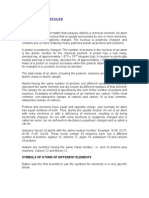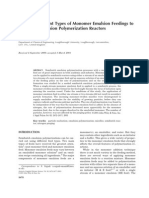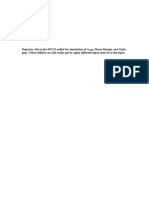0 ratings0% found this document useful (0 votes)
3 viewsScience Guide, 9th grade, september 09 th , 2024
Science Guide, 9th grade, september 09 th , 2024
Uploaded by
Elisa Tinococon Abeka
Copyright:
© All Rights Reserved
Available Formats
Download as DOCX, PDF, TXT or read online from Scribd
Science Guide, 9th grade, september 09 th , 2024
Science Guide, 9th grade, september 09 th , 2024
Uploaded by
Elisa Tinoco0 ratings0% found this document useful (0 votes)
3 views6 pagescon Abeka
Copyright
© © All Rights Reserved
Available Formats
DOCX, PDF, TXT or read online from Scribd
Share this document
Did you find this document useful?
Is this content inappropriate?
con Abeka
Copyright:
© All Rights Reserved
Available Formats
Download as DOCX, PDF, TXT or read online from Scribd
Download as docx, pdf, or txt
0 ratings0% found this document useful (0 votes)
3 views6 pagesScience Guide, 9th grade, september 09 th , 2024
Science Guide, 9th grade, september 09 th , 2024
Uploaded by
Elisa Tinococon Abeka
Copyright:
© All Rights Reserved
Available Formats
Download as DOCX, PDF, TXT or read online from Scribd
Download as docx, pdf, or txt
You are on page 1of 6
EDEN TECHNICAL TRILINGUAL KINDER GARDEN AND
SCHOOL
Science Guide:9th grade III Partial Date:____________
14.1 Compounds and Mixtures
Molecules and Compounds
Molecules:
A molecule is a group of atoms bonded together, representing the smallest unit of a
chemical compound that can take part in a chemical reaction. Molecules can consist
of two or more atoms of the same element (e.g., O₂) or different elements (e.g., H₂O).
Compounds:
Compounds are substances formed when two or more different elements are
chemically bonded together. They have different properties from the elements they
are made from. For example, water (H₂O) is a compound composed of hydrogen and
oxygen.
Exercises with Molecular Mass
Molecular Mass Calculation:
1.
Find the molecular mass of H₂O:
2.
1. Hydrogen (H): 1 amu × 2 = 2 amu
2. Oxygen (O): 16 amu × 1 = 16 amu
3. Total Molecular Mass = 2 + 16 = 18 amu
3.
Find the molecular mass of CO₂:
4.
1. Carbon (C): 12 amu × 1 = 12 amu
2. Oxygen (O): 16 amu × 2 = 32 amu
3. Total Molecular Mass = 12 + 32 = 44 amu
Pure Substances and Mixtures
Pure Substances:
A pure substance has a fixed composition and distinct properties. It can be an element
or a compound. For example, distilled water and table salt are pure substances.
Mixtures:
A mixture is a combination of two or more substances where each retains its own
properties. Mixtures can be homogeneous or heterogeneous.
Homogeneous Mixtures:
These mixtures have a uniform composition throughout. Examples include
saltwater and air.
Heterogeneous Mixtures:
These mixtures have a non-uniform composition. Examples include salad and
sand.
Comparison of Mixtures and Compounds
Mixtures:
o Can be separated by physical means (e.g., filtration, evaporation).
o Components retain their individual properties.
o Example: Sand and salt.
Compounds:
o Must be separated by chemical means (e.g., heating, chemical reactions).
o Components lose their individual properties.
o Example: Water (H₂O) is different from hydrogen and oxygen gases.
Ionic and Covalent Bonds
Ionic Bonds:
Formed when one atom gives up one or more electrons to another atom. This creates
ions (charged atoms) that attract each other. Example: Sodium chloride (NaCl).
Covalent Bonds:
Formed when two atoms share one or more pairs of electrons. This bond usually
occurs between nonmetals. Example: Water (H₂O).
Exercises with Ionic and Covalent Bonds
1.
Draw the ionic bond formation for NaCl:
2.
o Sodium (Na) loses an electron to become Na⁺.
o Chlorine (Cl) gains an electron to become Cl⁻.
o The resulting Na⁺ and Cl⁻ attract each other to form NaCl.
3.
Draw the covalent bond formation for H₂O:
4.
o Oxygen shares electrons with two Hydrogen atoms to form O-H bonds.
Lewis Structures
Lewis Structures:
A Lewis structure shows how atoms are bonded in a molecule and the lone pairs of
electrons. The octet rule is used to determine the arrangement of electrons.
Drawing a Lewis Structure:
1. Determine the total number of valence electrons.
2. Draw the basic structure with single bonds between atoms.
3. Distribute remaining electrons to satisfy the octet rule (8 electrons) for each atom.
Example: Draw a Lewis structure for CO₂:
Carbon (C) in the center.
Two Oxygens (O) on either side.
Each Oxygen shares two pairs of electrons with Carbon to complete the octet.
Electronegativity
Electronegativity:
A measure of an atom’s ability to attract and hold onto electrons in a chemical bond.
The higher the electronegativity, the more strongly an atom attracts electrons.
Example: Fluorine (F) has a high electronegativity, making it very effective at attracting
electrons.
Common Ions
Common Ions:
Cations (Positive ions): Formed when atoms lose electrons. Example: Na⁺, Ca²⁺.
Anions (Negative ions): Formed when atoms gain electrons. Example: Cl⁻, O²⁻.
Metallic Bond
Metallic Bond:
A bond formed between metal atoms where electrons are shared freely among a
lattice of metal cations. This "sea of electrons" contributes to properties like
conductivity and malleability.
Example: In metals like copper (Cu) or iron (Fe), metal atoms share their outer
electrons, creating a strong bond.
Naming Compounds
Naming Ionic Compounds:
Name the cation (metal) first, followed by the anion (non-metal).
Example: NaCl is named Sodium Chloride.
Naming Covalent Compounds:
Use prefixes to indicate the number of each atom (e.g., mono-, di-, tri-).
Example: CO₂ is named Carbon Dioxide.
Exercises
1.
Name the following ionic compounds:
2.
o KBr (Potassium Bromide)
o MgO (Magnesium Oxide)
3.
Name the following covalent compounds:
4.
o N₂O₅ (Dinitrogen Pentoxide)
o SF₆ (Sulfur Hexafluoride)
Chapter 14.2: Chemical Bonds: Forces
Within Molecules
1. Common Ions
Definition: Ions are charged particles formed when atoms gain or lose electrons.
Char Formu
Ion
ge la
Sodium +1 Na⁺
Chlorid
-1 Cl⁻
e
Calcium +2 Ca²⁺
Oxide -2 O²⁻
2. Ionic Crystals
Definition: Ionic crystals are formed by the electrostatic attraction between positive
and negative ions in a lattice structure.
Diagram of Ionic Crystal:
diff
Copiar código
+ - + - - + - + + - + - - + - +
3. Formula Mass
Definition: Formula mass is the sum of the atomic masses of all atoms in a formula
unit.
Example Calculation:
For NaCl:
Sodium (Na): 22.99 u
Chlorine (Cl): 35.45 u
Formula Mass = 22.99 + 35.45 = 58.44 u
4. Metallic Bonding
Definition: Metallic bonding involves a "sea of electrons" that are free to move
around, providing conductivity and malleability.
Diagram of Metallic Bonding:
diff
Copiar código
++++++
e e e e e+ + + + + +
5. Naming Compounds
Covalent Compounds: Use prefixes to denote the number of each type of atom (e.g., CO₂ is
carbon dioxide).
Ionic Compounds: Name the cation first and then the anion (e.g., NaCl is sodium chloride).
6. Chemical Formulas
Chemical Formula: Shows the types and numbers of atoms (e.g., H₂O).
Molecular Formula: Indicates the actual number of each type of atom in a molecule (e.g.,
C₆H₁₂O₆).
Structural Formula: Shows the arrangement of atoms in a molecule (e.g., H-O-H for water).
Chapter 14.3: Forces Between Molecules
1. Types of Intermolecular Forces
Dipole-Dipole Force: Attraction between polar molecules.
London Forces: Weak attractions caused by temporary dipoles in nonpolar molecules.
Hydrogen Bonds: Strong dipole-dipole attraction where hydrogen is bonded to N, O, or F.
Diagram of Intermolecular Forces:
css
Copiar código
H-O-H H-O-H
| |
| |
H-O-H H-O-H
2. Effects of Intermolecular Forces
Unit Cell: Smallest repeating unit in a crystal lattice.
Melting Point: Temperature at which a solid becomes a liquid.
Vapor Pressure: Pressure exerted by vapor in equilibrium with its liquid.
Boiling Point: Temperature at which a liquid boils.
Chapter 14.4: Solution Chemistry
1. Formation of Solution
The Solution Process:
Dissolution: Solvent molecules surround and interact with solute particles, separating them.
Rate of Dissolving:
Stirring, temperature, and surface area affect the rate at which a solute dissolves.
Solubility Terms:
Term Definition
Soluble Able to dissolve in a solvent.
Insoluble Unable to dissolve in a solvent.
Precipitate Solid that forms from a solution.
2. Solution Concentration
Mole: A unit measuring the amount of substance.
Molarity (M): Moles of solute per liter of solution.
Molality (m): Moles of solute per kilogram of solvent.
Normality (N): Equivalent of solute per liter of solution.
Exercises:
1. Calculate the molarity of a solution with 2 moles of solute in 1 liter of solution.
2. Determine the molality of a solution with 3 moles of solute in 0.5 kg of solvent.
Chapter 15: Chemistry in Action
15.1 Introduction to Chemical Reactions
Evidence of a Chemical Reaction:
Color change, gas production, precipitate formation, temperature change.
Chemical Equations:
Balanced Chemical Equation: Shows the same number of each type of atom on both sides of
the reaction.
Example:
2H2+O2→2H2O2H₂ + O₂ \rightarrow 2H₂O2H2+O2→2H2O
15.2 Chemical Thermodynamics and Reaction Rates
Chemical Thermodynamics: Study of energy changes during reactions.
Energy Changes:
o Exothermic Reaction: Releases heat (e.g., combustion).
o Endothermic Reaction: Absorbs heat (e.g., photosynthesis).
Diagram of Energy Changes:
markdown
Copiar código
Reactants Products
| |
|______________|
Energy is released/absorbed
Entropy: Measure of disorder; second law of thermodynamics states that entropy always
increases in an isolated system.
15.3 Salts, Acids, and Bases
Definitions:
Salts: Ionic compounds formed from the neutralization of an acid and a base.
Acids: Donate protons (e.g., HCl).
Bases: Accept protons (e.g., NaOH).
Neutralization Reactions:
HCl+NaOH→NaCl+H2OHCl + NaOH \rightarrow NaCl +
H₂OHCl+NaOH→NaCl+H2O
15.4 Oxidation, Reduction, and Electrochemistry
Redox Reactions: Involve the transfer of electrons between substances.
Electrochemical Cells:
Electrolyte: Substance that produces ions when dissolved.
Example: Zn-Cu electrochemical cell.
15.5 Organic Chemistry
Key Concepts:
Hydrocarbons:
o Alkanes: Saturated hydrocarbons (e.g., methane).
o Alkenes: Unsaturated hydrocarbons with double bonds (e.g., ethene).
o Aromatic Compounds: Contain benzene rings (e.g., benzene).
Functional Groups:
o Alcohols: Contain -OH group.
o Carboxylic Acids: Contain -COOH group.
Diagram of Hydrocarbons:
mathematica
Copiar código
Methane (CH₄):
H
|H-C-H
|
H
Ethene (C₂H₄):
H H
\/
C=C
/\
H H
15.6 Biochemistry: The Chemistry of Life
Carbohydrates:
Monosaccharides: Single sugars (e.g., glucose).
Disaccharides: Two sugar units (e.g., sucrose).
Polysaccharides: Complex carbohydrates (e.g., cellulose).
Lipids:
Cholesterol: A type of lipid with LDL (bad) and HDL (good) forms.
Proteins:
Amino Acids: Building blocks of proteins, linked by peptide bonds.
Types of Proteins: Enzymes, structural proteins, etc.
Nucleic Acids:
DNA: Stores genetic information.
RNA: Messenger for protein synthesis.
Diagram of DNA Structure:
scss
Copiar código
Phosphate - Sugar - Base
| | |
-- -- --
Adenine - Thymine (A-T)
Cytosine - Guanine (C-G)
You might also like
- Steven W. Ellingson-Radio Systems Engineering-Cambridge University Press (2016)Document716 pagesSteven W. Ellingson-Radio Systems Engineering-Cambridge University Press (2016)Ankit Smith100% (3)
- C9e Answers Active Reading 02Document6 pagesC9e Answers Active Reading 02Jaden VenturaNo ratings yet
- Excel Finance Tricks 1-17 FinishedDocument52 pagesExcel Finance Tricks 1-17 FinishedXenopol XenopolNo ratings yet
- Chemistry Lessons - High School LevelDocument5 pagesChemistry Lessons - High School LevelacadsdemicNo ratings yet
- Introduction To ChemistryDocument35 pagesIntroduction To Chemistryzeeshan783aminNo ratings yet
- Chemistry ReviewerDocument3 pagesChemistry ReviewerWendel Delos ReyesNo ratings yet
- ChemistryNotesDocument3 pagesChemistryNotessuju.miracleNo ratings yet
- Hidzqi SA - 15A - Assingment 3Document2 pagesHidzqi SA - 15A - Assingment 3hidzqiNo ratings yet
- (CHEMISTRYDocument6 pages(CHEMISTRYcponnusamy411No ratings yet
- CHEMISTRYDocument14 pagesCHEMISTRYAKSHAY MANo ratings yet
- CHEMISTRY - (With Answers)Document23 pagesCHEMISTRY - (With Answers)Arnold MutasaNo ratings yet
- ChemistryDocument3 pagesChemistryzde20637No ratings yet
- Slo Based Questions Class 9th chemi-WPS Office-CompressedDocument7 pagesSlo Based Questions Class 9th chemi-WPS Office-CompressedHibba KhanNo ratings yet
- Notes of CH 3 Atoms and Molecules Class 9th ScienceDocument11 pagesNotes of CH 3 Atoms and Molecules Class 9th ScienceSingh J100% (2)
- Atoms and MoleculesDocument10 pagesAtoms and MoleculesAJ BrothersNo ratings yet
- Atom and MoleculesDocument15 pagesAtom and MoleculesSaim BNo ratings yet
- Basics of Water ChemistryDocument51 pagesBasics of Water ChemistryRavi ShankarNo ratings yet
- FY 1measurement of MatterDocument7 pagesFY 1measurement of Mattersathvikjune2111No ratings yet
- CHEMISTRY - (With Answers)Document23 pagesCHEMISTRY - (With Answers)Arnold MutasaNo ratings yet
- IG Unit - 2Document59 pagesIG Unit - 2KizukiNo ratings yet
- Week 10-13 (Handout)Document10 pagesWeek 10-13 (Handout)Mary Cris MovillaNo ratings yet
- Compounds: From Elements To CompoundsDocument3 pagesCompounds: From Elements To CompoundsUnikeNo ratings yet
- Composition of Matter: Atom, Molecule Chapter-1: Answer To The Short QuestionsDocument15 pagesComposition of Matter: Atom, Molecule Chapter-1: Answer To The Short QuestionsG M Ali KawsarNo ratings yet
- Lecture 2 Atomic StructureDocument32 pagesLecture 2 Atomic StructureAhmed FouadNo ratings yet
- Nota KimiaDocument18 pagesNota KimiaAzmi Bin A Matali100% (1)
- Extrascore Sample Questions - AnswersDocument4 pagesExtrascore Sample Questions - AnswersDeepak ThakurNo ratings yet
- The Chemical Earth-Ahmad ShahDocument46 pagesThe Chemical Earth-Ahmad ShahYouseffNo ratings yet
- Lecture Note PDFDocument91 pagesLecture Note PDFGamachis Mulugeta100% (1)
- BIOLS102 Chapter2 2018Document43 pagesBIOLS102 Chapter2 2018ptp4mz9rkcNo ratings yet
- MLP HLP IX ch3Document4 pagesMLP HLP IX ch3Atharva VarshneyNo ratings yet
- Biology 25: Human Biology: Prof. Gonsalves Los Angeles City College Loosely Based On Mader's Human Biology, 7 EditionDocument119 pagesBiology 25: Human Biology: Prof. Gonsalves Los Angeles City College Loosely Based On Mader's Human Biology, 7 EditionRhaine EstebanNo ratings yet
- Chapter 04 Part 1Document4 pagesChapter 04 Part 1Dana CapbunNo ratings yet
- Chemistry I: Notes For First Semester College ChemistryDocument5 pagesChemistry I: Notes For First Semester College ChemistrystudenflNo ratings yet
- Chemistry NotesDocument3 pagesChemistry Notesanniefernz2003No ratings yet
- Chemistry NotesDocument3 pagesChemistry Notesanniefernz2003No ratings yet
- Chemistry Document 1Document4 pagesChemistry Document 1fayyaz01alamNo ratings yet
- Atoms and MolsDocument8 pagesAtoms and MolsPurpiel PupyNo ratings yet
- Unit 1 Module 1Document38 pagesUnit 1 Module 1Pearl NecoleNo ratings yet
- Basic Concepts of Chemistry.Document9 pagesBasic Concepts of Chemistry.Archith NinanNo ratings yet
- Chem 101-inorganicDocument55 pagesChem 101-inorganickokyalfeky11No ratings yet
- Chemistry 1 MarksDocument2 pagesChemistry 1 Marksgcom0895No ratings yet
- Chapter 2 Jan12Document55 pagesChapter 2 Jan12Amir NasrinNo ratings yet
- General ChemistryDocument6 pagesGeneral ChemistryJewel ValenciaNo ratings yet
- Ch2 Atoms, Molecules, and Ions 1Document18 pagesCh2 Atoms, Molecules, and Ions 1Ariyandi PurnamaNo ratings yet
- CHAPTER FOUR-RevisedDocument16 pagesCHAPTER FOUR-RevisedShimelis NigusieNo ratings yet
- IB Chemistry HL Summer Assignment 2024-25 - Year 1Document9 pagesIB Chemistry HL Summer Assignment 2024-25 - Year 1kjdaniel27No ratings yet
- 3 CH 1 Sec 3 Compunds and Mixtures UploadDocument34 pages3 CH 1 Sec 3 Compunds and Mixtures Uploadapi-270861823No ratings yet
- Chem RevisionDocument5 pagesChem RevisiontomeveeNo ratings yet
- Atomic StructureDocument5 pagesAtomic Structuredain.saukaitisNo ratings yet
- 9th Atoms and Molecules Revision Notes-1Document10 pages9th Atoms and Molecules Revision Notes-1ADITYA RAI100% (1)
- Basic Definitions and VocabularyDocument6 pagesBasic Definitions and VocabularyÏt's RîçkgãrçīäNo ratings yet
- Chemistry Form 4 Definition ListDocument5 pagesChemistry Form 4 Definition ListyeeteinNo ratings yet
- 139 Chap10Document32 pages139 Chap10Umer Iftikhar AhmedNo ratings yet
- List of Definition in Chemistry F4Document7 pagesList of Definition in Chemistry F4Lil' Nyeh100% (1)
- Definitions (Ol) RevisedDocument17 pagesDefinitions (Ol) RevisedTahsin HusainNo ratings yet
- Ocr A Chemistry DefinitionDocument44 pagesOcr A Chemistry DefinitionCHRONIKNo ratings yet
- Definitions Module 2Document7 pagesDefinitions Module 2CHRONIKNo ratings yet
- 6 Chemical Bonding and Structures of Environmental PollutantsDocument20 pages6 Chemical Bonding and Structures of Environmental PollutantsMaaz WaseemNo ratings yet
- J SX 66 A PL6 em DSsip 1 e OQDocument33 pagesJ SX 66 A PL6 em DSsip 1 e OQprincejaisawal2mNo ratings yet
- 9 Chapter-3Document13 pages9 Chapter-3dl9s6547No ratings yet
- G4-REPORTDocument64 pagesG4-REPORTcarylalcantara94No ratings yet
- ID Analisis Penggunaan Polydimethyl Siloxan PDFDocument8 pagesID Analisis Penggunaan Polydimethyl Siloxan PDFBudi nico candra SimanullangNo ratings yet
- Rotary Broaching - MikesworkshopDocument1 pageRotary Broaching - MikesworkshopPhilipe WandembergNo ratings yet
- Question 3Document4 pagesQuestion 3Ramesh ShresthaNo ratings yet
- 501 On Line Quiz Audit SamplingDocument2 pages501 On Line Quiz Audit SamplingHeinie Joy PauleNo ratings yet
- Dali Epikore 11 - White PaperDocument38 pagesDali Epikore 11 - White PaperBay Bloor RadioNo ratings yet
- Enous Hromboembolism Report Form:: HospitalDocument4 pagesEnous Hromboembolism Report Form:: HospitalHosam GomaaNo ratings yet
- Engineering Maths 2Document3 pagesEngineering Maths 2Sameer SyedNo ratings yet
- FI S4 FunctionalitiesDocument31 pagesFI S4 FunctionalitiesNikhil KaikadeNo ratings yet
- Komku Blog Install Windows XP Using USB Flash Disk Flash Drive - Step by Step GuideDocument45 pagesKomku Blog Install Windows XP Using USB Flash Disk Flash Drive - Step by Step Guideahmadhilmi890% (1)
- Dos Ii PPT 2Document40 pagesDos Ii PPT 2revathisasikumar5420No ratings yet
- Crazy BallDocument22 pagesCrazy BallbellissimiNo ratings yet
- Wireless Power Project Proposal-LibreDocument17 pagesWireless Power Project Proposal-LibrekevinkevzNo ratings yet
- Instruction Manual: Model#: 119203C LIT #: 98-1164/03-10Document12 pagesInstruction Manual: Model#: 119203C LIT #: 98-1164/03-10david churaNo ratings yet
- Examples of Most MapleTA Question TypesDocument17 pagesExamples of Most MapleTA Question TypesMary Grace Peralta ParagasNo ratings yet
- Governance in Little RockDocument18 pagesGovernance in Little RockRuss RacopNo ratings yet
- Wireless Repeater ManualDocument11 pagesWireless Repeater ManualtheanhcbNo ratings yet
- Genz Benz ShuttleMax 12.2 ManualDocument9 pagesGenz Benz ShuttleMax 12.2 ManualBrandon PowellNo ratings yet
- FisikaDocument12 pagesFisikaMuhammad AriefNo ratings yet
- Guide For Using IMacros To Pull Real Estate RecordsDocument17 pagesGuide For Using IMacros To Pull Real Estate RecordstuyetlexeNo ratings yet
- Study of Different Types of Monomer Emulsion Feedings To Semibatch Emulsion Polymerization ReactorsDocument6 pagesStudy of Different Types of Monomer Emulsion Feedings To Semibatch Emulsion Polymerization ReactorsYan ChenNo ratings yet
- 6.3.30 GEC4-M Mathematics in The Modern WorldDocument8 pages6.3.30 GEC4-M Mathematics in The Modern WorldNechole Villaflores RogelioNo ratings yet
- Instrumentation & MeasurementDocument2 pagesInstrumentation & MeasurementPrashant GautamNo ratings yet
- Tugas Timbunan XstablDocument5 pagesTugas Timbunan Xstabllutfatul MuchlisohNo ratings yet
- UK National Grid in Talks To Build Energy Island in The North SeaDocument1 pageUK National Grid in Talks To Build Energy Island in The North SeaHÀ ĐỖ VIẾTNo ratings yet
- Lsc320an02 T SamsungDocument36 pagesLsc320an02 T SamsungStephen Eric MilagrosaNo ratings yet
- JEE Advanced Crash Course Planar - MathonGoDocument3 pagesJEE Advanced Crash Course Planar - MathonGoSoham ChakrabortyNo ratings yet
- Spice NetlistDocument5 pagesSpice NetlisticdaneNo ratings yet
- Highway Research Journal Vol 5 - No 2 PDFDocument48 pagesHighway Research Journal Vol 5 - No 2 PDFAyyanna HabalNo ratings yet

























































































